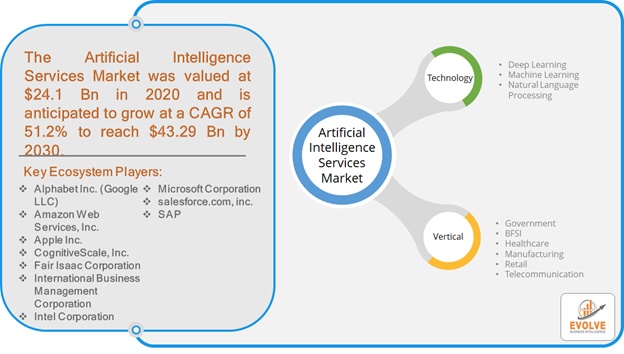Artificial Intelligence Services Market Analysis and Global Forecast 2022-2030
$ 1,390.00 – $ 5,520.00Price range: $ 1,390.00 through $ 5,520.00
The global Artificial Intelligence Services market size is projected to reach approximately $43.29 Billion by 2030
Report Code: EB_ICT | Page: 170 | Published Date: Upcoming
The global Artificial Intelligence Services market size is projected to reach approximately $43.29 Billion by 2030, at a CAGR of 51.2% from 2022 to 2030. Artificial Intelligence Service is a company that outsources artificial intelligence (AI). It allows individuals and organizations to explore many pathways for various reasons without a large initial commitment and with minimal risk. Most smart vendors, whether software companies, consultants, or professional service businesses, offer or partner with companies that can provide a comprehensive set of services to support a large-scale AI solution. This is because AI market service providers recognize that simply providing AI software or AI toolsets to their clients is no longer sufficient. AI services have been aggressively adopted as a major part of the technologies of companies such as IBM, Microsoft, Google, and others.
COVID-19 Impact Analysis
Due to COVID-19, businesses have been moving forward with plans to digitize and automate elements of their operations, not only to improve operational efficiencies but also to defend themselves from interruptions. Various organizations faced considerable increases in customer pressure during the pandemic, but their number of available personnel was reduced. Various contact centers were unable to meet demand or were forced to close due to lockdown restrictions, resulting in lengthy delays in customer support requests and a negative impact on the customer experience. As a result, conversational AI has risen to the top of the list of technology enablers.
Artificial Intelligence Services Market Dynamics
The continuous advancements in the field of artificial intelligence, increased investments in R&D, continuous advancements in the field of artificial intelligence, increased investments in R&D, and other reasons have all contributed to artificial intelligence service business all contributed to artificial intelligence as a service business.
Drivers:
⮚ Robotic autonomy is required to be competitive in a market
The robotics sector is transforming due to AI, particularly computer vision and machine learning. Businesses are exploring completely autonomous robots that can perceive, interact, and conceive the environment around them to stay ahead in a global market. Industries are looking for dependable and experienced technology partners as they begin to navigate this current technological transformation. Deep learning models handle enormous amounts of data, such as photos, texts, and sounds, using artificial neural networks to produce correct results. Artificial intelligence-driven automation has proven effective in a variety of areas, including aviation, medical, agriculture, energy, and material handling. This means that an ever-changing workforce trained in robots and modern manufacturing is required.
Restraint:
- There are a limited number of AI service expert
Artificial Intelligence is a complex system, and companies need workers with specific skill sets to develop, manage, and implement AI services. For instance, workers who work with AI systems should be familiar with technologies such as cognitive computing, ML and machine intelligence, deep learning, and image recognition. Integrating AI solutions with existing systems is a difficult task that necessitates extensive data processing to replicate the behavior of a human brain. Even minor errors can cause system failure or malfunctioning of a specific solution, which can have a significant impact on outcomes and desired results.
Opportunity:
⮚ Increased government initiatives to use AI technology
Growing applications and simple deployment techniques have drawn governments’ attention to AI technology, resulting in increased government investments in AI and related technologies. Government agencies, public sector organizations, and non-governmental organizations have begun allocating funds for AI-based pilot initiatives in a variety of areas, including road and public safety, traffic management, and government document digitalization.
Artificial Intelligence Services Segment Overview
By Technology
Based on the Technology, the Artificial Intelligence Services market is segmented based on Deep Learning, Machine Learning, and Natural Language Processing. During the projection period, the machine learning and deep learning technology category are expected to hold the largest market share, while natural language processing technology is expected to rise at a faster CAGR. Natural language processing technology is capable of comprehending user behavior, which aids in the delivery of improved customer service.
By Vertical
Based on Vertical, the global Artificial Intelligence Services market has been divided into Government, BFSI, Healthcare, Manufacturing, Retail, and Telecommunication. The BFSI segment is expected to hold the largest market share. Artificial Intelligence Services is increasingly being used in the BFSI business to improve operational efficiency and provide a better customer experience. AI is at the forefront of all technological advancements.
Global Artificial Intelligence Services Market Share, by Segmentation
 Artificial Intelligence Services Regional Analysis
Artificial Intelligence Services Regional Analysis
Based on region, the global Artificial Intelligence Services market has been divided into North America, Europe, Asia-Pacific, and the Rest of the World. North America is projected to dominate the use of the Artificial Intelligence Services market followed by the Asia-Pacific and Europe regions.
North America Market
North America has produced and contributed to the largest artificial intelligence service market share due to its early embrace of modern technologies such as artificial intelligence. Advanced infrastructure, sophisticated network technologies, and strong technical capabilities are also contributing to its enormous artificial intelligence service market size.
Asia-Pacific Market
During the forecast years, Asia Pacific is expected to increase at the fastest rate. The countries of China, Japan, and South Korea are the region’s major artificial intelligence inventors. One of the primary causes driving the rise and adoption of artificial intelligence in China and South Korea is their heavy investment in creating automation technologies for companies.
Competitive Landscape
The market comprises tier-1, tier-2, and local players. With their wide product portfolios, tier-1 and tier-2 players have a global reach. Since of their strategic innovations and broad regional presence, companies such as amazon web services inc, apple inc, cognitivescale inc, fair Isaac corporation, and international business management corporations lead the global Artificial Intelligence Services business. To increase their market position and attract a wide consumer base, the businesses are employing various strategies, such as growth, product releases, and alliances.
Prominent Players:
- Alphabet Inc. (Google LLC)
- Amazon Web Services Inc
- Apple Inc
- CognitiveScale Inc
- Fair Isaac Corporation
- International Business Management Corporation
- Intel Corporation
- Microsoft Corporation
- salesforce inc
- SAP
Scope of the Report
Global Artificial Intelligence Services Market, by Technology
- Deep Learning
- Machine Learning
- Natural Language Processing
Global Artificial Intelligence Services Market, by Vertical
- Government
- BFSI
- Healthcare
- Manufacturing
- Retail
- Telecommunication
Global Artificial Intelligence Services Market, by Region
- North America
- US
- Canada
- Mexico
- Europe
- UK
- Germany
- France
- Italy
- Rest of Europe
- Asia Pacific
- China
- Japan
- South Korea
- India
- Rest of Asia Pacific
- Rest of the World
| Parameters | Indicators |
|---|---|
| Market Size | 2030: $ 43.29 Billion |
| CAGR | 51.2% CAGR (2022-2030) |
| Base year | 2021 |
| Forecast Period | 2022-2030 |
| Historical Data | 2020 |
| Report Coverage | Revenue Forecast, Competitive Landscape, Growth Factors, and Trends |
| Key Segmentations | Technology, Vertical |
| Geographies Covered | North America, Europe, Asia-Pacific, Latin America, Middle East, Africa |
| Key Vendors | Amazon Web Services Inc, Alphabet Inc (Google LLC), Apple Inc, Fair Isaac Corporation, CognitiveScale Inc, Intel Corporation, International Business Management Corporation, Microsoft Corporation, salesforce.com inc, SAP |
| Key Market Opportunities | Increased government initiatives to use AI technology |
| Key Market Drivers | Robotic autonomy is required to be competitive in a market |
REPORT CONTENT BRIEF:
- High-level analysis of the current and future Artificial Intelligence Services market trends and opportunities
- Detailed analysis of current market drivers, restraining factors, and opportunities in the future
- Artificial Intelligence Services market historical market size for the year 2020, and forecast from 2022 to 2030
- Artificial Intelligence Services market share analysis at each product level
- Competitor analysis with a detailed insight into its product segment, financial strength, and strategies adopted.
- Identifies key strategies adopted including product launches and developments, mergers and acquisitions, joint ventures, collaborations, and partnerships as well as funding taken and investment done, among others.
- To identify and understand the various factors involved in the global Artificial Intelligence Services market affected by the pandemic
- To provide a detailed insight into the major companies operating in the market. The profiling will include the financial health of the company past 2-3 years with segmental and regional revenue breakup, product offering, recent developments, SWOT analysis, and key strategies.
Press Release

Global Pharmaceutical Manufacturing Market to Reach $1.38 Trillion by 2035 with 7.35% CAGR, New Research Shows

The Global Mammography Market Is Estimated To Record a CAGR of Around 10.29% During The Forecast Period

Glue Stick Market to Reach USD 2.35 Billion by 2034

Podiatry Service Market to Reach USD 11.88 Billion by 2034

Microfluidics Technology Market to Reach USD 32.58 Billion by 2034

Ferric Chloride Market to Reach USD 10.65 Billion by 2034

Family Practice EMR Software Market to Reach USD 21.52 Billion by 2034

Electric Hairbrush Market to Reach USD 15.95 Billion by 2034

Daily Bamboo Products Market to Reach USD 143.52 Billion by 2034

Cross-border E-commerce Logistics Market to Reach USD 112.65 Billion by 2034
Frequently Asked Questions (FAQ)
What is the study period of this market?
The study period of the global Artificial Intelligence Services market is 2020 - 2030
What is the growth rate of the global Artificial Intelligence Services market?
The global Artificial Intelligence Services market is growing at a CAGR of ~ 51.2% over the next 7 years
Which region has the highest growth rate in the global Artificial Intelligence Services market?
Asia Pacific is expected to register the highest CAGR during 2022-2030
Which region has the largest share in the global Artificial Intelligence Services market?
North America holds the largest share in 2021
Who are the key players in the global Artificial Intelligence Services market?
Alphabet Inc (Google LLC), Amazon Web Services Inc, Apple Inc, CognitiveScale Inc, Fair Isaac Corporation, International Business Management Corporation, Intel Corporation, Microsoft Corporation, salesforce.com inc, SAP are the major companies operating in the global Artificial Intelligence Services market.
Do you offer Post Sale Support?
Yes, we offer 16 hours of analyst support to solve the queries
Do you sell particular sections of a report?
Yes, we provide regional as well as country-level reports. Other than this we also provide a sectional report. Please get in contact with our sales representatives.
Table of Contents
Chapter 1. Executive Summary Chapter 2. Scope Of Study 2.1. Market Definition 2.2. Scope Of The Study 2.2.1. Objectives of Report 2.2.2. Limitations 2.3. Market Structure Chapter 3. Evolve BI Methodology Chapter 4. Market Insights and Trends 4.1. Supply/ Value Chain Analysis 4.1.1. Raw Vertical Providers 4.1.2. Manufacturing Process 4.1.3. Distributors/Retailers 4.1.4. End Users 4.2. Porter’s Five Forces Analysis 4.2.1. Threat Of New Entrants 4.2.2. Bargaining Power Of Buyers 4.2.3. Bargaining Power Of Suppliers 4.2.4. Threat Of Substitutes 4.2.5. Industry Rivalry 4.3. Impact Of COVID-19 on Artificial Intelligence Services 4.3.1. Impact on Market Size 4.3.2. End-User Trend, Preferences, and Budget Impact 4.3.3. Regulatory Framework/Government Policies 4.3.4. Key Players' Strategy to Tackle Negative Impact 4.3.5. Opportunity Window 4.4. Technology Overview 4.5. Macro factor 4.6. Micro Factor 4.7. Demand Supply Gap Analysis of Artificial Intelligence Services 4.8. Import Analysis of Artificial Intelligence Services 4.9. Export Analysis of Artificial Intelligence Services Chapter 5. Market Dynamics 5.1. Introduction 5.2. DROC Analysis 5.2.1. Drivers 5.2.2. Restraints 5.2.3. Opportunities 5.2.4. Challenges 5.3. Patent Analysis 5.4. Industry Roadmap 5.5. Parent/Peer Market Analysis Chapter 6. Global Artificial Intelligence Services, By Technology 6.1. Introduction 6.2. Deep Learning 6.3. Machine Learning 6.4. Natural Language Processing Chapter 7. Global Artificial Intelligence Services, By Vertical 7.1. Introduction 7.2. Government 7.3. BFSI 7.4. Healthcare 7.5. Manufacturing 7.6. Retail 7.7. Telecommunication Chapter 8. Global Artificial Intelligence Services, By Region 8.1. Introduction 8.2. North America 8.2.1. Introduction 8.2.2. Driving Factors, Opportunity Analyzed, and Key Trends 8.2.3. Market Size and Forecast, By Country, 2020 - 2030 8.2.4. Market Size and Forecast, By Technology, 2020 - 2030 8.2.5. Market Size and Forecast, By Vertical, 2020 – 2028 8.2.6. US 8.2.6.1. Introduction 8.2.6.2. Driving Factors, Opportunity Analyzed, and Key Trends 8.2.6.3. Market Size and Forecast, By Technology, 2020 - 2030 8.2.6.4. Market Size and Forecast, By Vertical, 2020 - 2030 8.2.7. Canada 8.2.7.1. Introduction 8.2.7.2. Driving Factors, Opportunity Analyzed, and Key Trends 8.2.7.3. Market Size and Forecast, By Technology, 2020 - 2030 8.2.7.4. Market Size and Forecast, By Vertical, 2020 - 2030 8.3. Europe 8.3.1. Introduction 8.3.2. Driving Factors, Opportunity Analyzed, and Key Trends 8.3.3. Market Size and Forecast, By Country, 2020 - 2030 8.3.4. Market Size and Forecast, By Technology, 2020 - 2030 8.3.5. Market Size and Forecast, By Vertical, 2020 – 2028 8.3.6. Germany 8.3.6.1. Introduction 8.3.6.2. Driving Factors, Opportunity Analyzed, and Key Trends 8.3.6.3. Market Size and Forecast, By Technology, 2020 - 2030 8.3.6.4. Market Size and Forecast, By Vertical, 2020 - 2030 8.3.7. France 8.3.7.1. Introduction 8.3.7.2. Driving Factors, Opportunity Analyzed, and Key Trends 8.3.7.3. Market Size and Forecast, By Technology, 2020 - 2030 8.3.7.4. Market Size and Forecast, By Vertical, 2020 - 2030 8.3.8. UK 8.3.8.1. Introduction 8.3.8.2. Driving Factors, Opportunity Analyzed, and Key Trends 8.3.8.3. Market Size and Forecast, By Technology, 2020 - 2030 8.3.8.4. Market Size and Forecast, By Vertical, 2020 - 2030 8.3.8. Italy 8.3.9.1. Introduction 8.3.9.2. Driving Factors, Opportunity Analyzed, and Key Trends 8.3.9.3. Market Size and Forecast, By Technology, 2020 - 2030 8.3.9.4. Market Size and Forecast, By Vertical, 2020 - 2030 8.3.10. Rest Of Europe 8.3.10.1. Introduction 8.3.10.2. Driving Factors, Opportunity Analyzed, and Key Trends 8.3.10.3. Market Size and Forecast, By Technology, 2020 - 2030 8.3.10.4. Market Size and Forecast, By Vertical, 2020 - 2030 8.4. Asia-Pacific 8.4.1. Introduction 8.4.2. Driving Factors, Opportunity Analyzed, and Key Trends 8.4.3. Market Size and Forecast, By Country, 2020 - 2030 8.4.4. Market Size and Forecast, By Technology, 2020 - 2030 8.4.5. Market Size and Forecast, By Vertical, 2020 - 2030 8.4.6. China 8.4.6.1. Introduction 8.4.6.2. Driving Factors, Opportunity Analyzed, and Key Trends 8.4.6.3. Market Size and Forecast, By Technology, 2020 - 2030 8.4.6.4. Market Size and Forecast, By Vertical, 2020 - 2030 8.4.7. India 8.4.7.1. Introduction 8.4.7.2. Driving Factors, Opportunity Analyzed, and Key Trends 8.4.7.3. Market Size and Forecast, By Technology, 2020 - 2030 8.4.7.4. Market Size and Forecast, By Vertical, 2020 - 2030 8.4.8. Japan 8.4.8.1. Introduction 8.4.8.2. Driving Factors, Opportunity Analyzed, and Key Trends 8.4.8.3. Market Size and Forecast, By Technology, 2020 - 2030 8.4.8.4. Market Size and Forecast, By Vertical, 2020 - 2030 8.4.9. South Korea 8.4.9.1. Introduction 8.4.9.2. Driving Factors, Opportunity Analyzed, and Key Trends 8.4.9.3. Market Size and Forecast, By Technology, 2020 - 2030 8.4.9.4. Market Size and Forecast, By Vertical, 2020 - 2030 8.4.10. Rest Of Asia-Pacific 8.4.10.1. Introduction 8.4.10.2. Driving Factors, Opportunity Analyzed, and Key Trends 8.4.10.3. Market Size and Forecast, By Technology, 2020 - 2030 8.4.10.4. Market Size and Forecast, By Vertical, 2020 - 2030 8.5. Rest Of The World (RoW) 8.5.1. Introduction 8.5.2. Driving Factors, Opportunity Analyzed, and Key Trends 8.5.3. Market Size and Forecast, By Technology, 2020 - 2030 8.5.4. Market Size and Forecast, By Vertical, 2020 - 2030 8.5.5. Market Size and Forecast, By Region, 2020 - 2030 8.5.6. South America 8.5.6.1. Introduction 8.5.6.2. Driving Factors, Opportunity Analyzed, and Key Trends 8.5.6.3. Market Size and Forecast, By Technology, 2020 - 2030 8.5.6.4. Market Size and Forecast, By Vertical, 2020 - 2030 8.5.7. Middle East and Africa 8.5.7.1. Introduction 8.5.7.2. Driving Factors, Opportunity Analyzed, and Key Trends 8.5.7.3. Market Size and Forecast, By Technology, 2020 - 2030 8.5.7.4. Market Size and Forecast, By Vertical, 2020 - 2030 Chapter 9. Competitive Landscape 9.1. Introduction 9.2. Vendor Share Analysis, 2021/Key Players Positioning, 2021 Chapter 10. Company Profiles 10.1. Alphabet Inc. (Google LLC) 10.1.1. Business Overview 10.1.2. Financial Analysis 10.1.3. Product Portfolio 10.1.4. Recent Development and Strategies Adopted 10.1.5. SWOT Analysis 10.2. Amazon Web Services, Inc. 10.2.1. Business Overview 10.2.2. Financial Analysis 10.2.3. Product Portfolio 10.2.4. Recent Development and Strategies Adopted 10.2.5. SWOT Analysis 10.3. Apple Inc. 10.3.1. Business Overview 10.3.2. Financial Analysis 10.3.3. Product Portfolio 10.3.4. Recent Development and Strategies Adopted 10.3.5. SWOT Analysis 10.4. CognitiveScale, Inc. 10.4.1. Business Overview 10.4.2. Financial Analysis 10.4.3. Product Portfolio 10.4.4. Recent Development and Strategies Adopted 10.4.5. SWOT Analysis 10.5. Fair Isaac Corporation 10.5.1. Business Overview 10.5.2. Financial Analysis 10.5.3. Product Portfolio 10.5.4. Recent Development and Strategies Adopted 10.5.5. SWOT Analysis 10.6. International Business Management Corporation 10.6.1. Business Overview 10.6.2. Financial Analysis 10.6.3. Product Portfolio 10.6.4. Recent Development and Strategies Adopted 10.6.5. SWOT Analysis 10.7. Intel Corporation 10.7.1. Business Overview 10.7.2. Financial Analysis 10.7.3. Product Portfolio 10.7.4. Recent Development and Strategies Adopted 10.7.5. SWOT Analysis 10.8. Microsoft Corporation 10.8.1. Business Overview 10.8.2. Financial Analysis 10.8.3. Product Portfolio 10.8.4. Recent Development and Strategies Adopted 10.8.5. SWOT Analysis 10.9. Salesforce, inc. 10.9.1. Business Overview 10.9.2. Financial Analysis 10.9.3. Product Portfolio 10.9.4. Recent Development and Strategies Adopted 10.9.5. SWOT Analysis 10.10. SAP 10.10.1. Business Overview 10.10.2. Financial Analysis 10.10.3. Product Portfolio 10.10.4. Recent Development and Strategies Adopted 10.10.5. SWOT Analysis Chapter 11. Key Takeaways
Connect to Analyst
Research Methodology



 Artificial Intelligence Services Regional Analysis
Artificial Intelligence Services Regional Analysis





